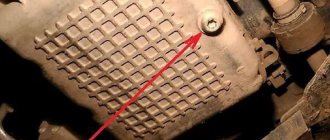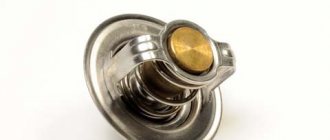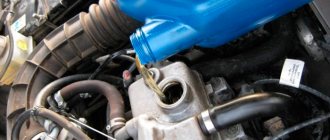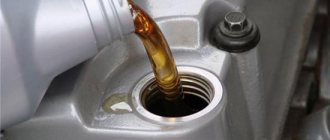Maintenance schedule for internal combustion engine VAZ 11189
The manufacturer in the service book outlined the following regulations for replacing consumables:
- engine oil and corresponding filter every 15 thousand km;
- spark plugs, fuel and air filters are changed after one service;
- rivulet belt and coolant every 90 thousand km.
At each maintenance, the valves are checked and, if necessary, adjusted.
Many people advise reducing the maintenance interval to 10 thousand km and changing the oil on a warm engine. This will allow the resource of 200,000 km declared by the manufacturer to be doubled.
Tools
Of course, you will need to purchase or prepare some materials, the main ones being oil fluid and a filter. Along with them you will need:
- container for draining waste;
- hexagons, keys;
- screwdrivers;
- heads;
- rags;
- funnel;
- rubber gloves designed to protect hands.
Step-by-step instruction
Changing the oil in the VAZ 2114 engine
Changing the oil in the box is carried out on a well-warmed-up car.
Important! The temperature of the transmission fluid in the box of the Lada Largus should be 60 degrees. Determined by a special device - a scanner
If this is not the case, the car warms up to the operating temperature of the internal combustion engine. The gearbox lubricant temperature will correspond to 60 degrees. This will facilitate good oil drainage. Fig 3
It is determined by a special device - a scanner. If this is not the case, the car warms up to the operating temperature of the internal combustion engine. The gearbox lubricant temperature will correspond to 60 degrees. This will facilitate good oil drainage. Fig 3
Is it worth changing the oil in manual transmissions at all - video
The transmission oil poured into the gearbox is designed for the entire life of the vehicle and the maintenance schedule does not include operations for checking the level and changing the oil. At the same time, we recommend checking the oil level in the gearbox at every service and always when an oil leak is detected from the gearbox. We carry out the work on an inspection ditch or overpass. We check the oil level through the control (filler) hole on a cooled gearbox. The inspection hole is located on the front wall of the gearbox housing and is closed with a threaded plastic plug. We remove the power unit protection (see “Removing the power unit protection”). Use a rag to clean the gearbox housing around the inspection hole.
We unscrew the control hole plug counterclockwise. The plug is sealed with a rubber gasket. If the gasket is torn or has lost elasticity, replace it with a new one. The oil level in the gearbox should be level with the lower edge of the hole, which can be checked with your finger. If necessary, add oil of the same brand that was poured into the gearbox. A syringe for filling transmission oil...
... add oil to the gearbox to the bottom edge of the hole (oil will begin to flow out of the hole). When the excess oil has flowed out, use a rag to remove any oil spills and tighten the plug. If it is necessary to drain the oil from the gearbox (for example, when replacing the wheel drive oil seal), clean the gearbox housing around the drain hole. We place a container with a volume of at least 3.5 liters under the drain hole.
Unscrew the drain plug with a square “8”... ... and drain the oil into a container.
For sealing, a copper washer is installed under the plug. Once draining is complete, screw in the drain plug. After completing the repair work, pour oil into the gearbox through the inspection hole and tighten the plug.
Lada Largus is the best-selling Russian station wagon. Good driving characteristics, a spacious interior, high comfort and reliability - all these qualities made the car popular even on the secondary market. The simple design allows you to maintain the car yourself, and thereby save on repairs. So, during self-service, one of the most popular procedures is not only replacement, but also selection in the gearbox. Any motorist can handle this. And yet, even experienced car enthusiasts may have questions about this. In this article we will take a closer look at how to choose the right oil for a Lada Largus manual transmission.
Let's consider the criteria for choosing transmission oil for Lada Largus. The question of choosing a suitable lubricant for a manual transmission usually arises after 15-20 thousand kilometers, when it is time to change the fluid. The Russian station wagon is equipped with two types of gearboxes – JH1 (for a 1.4-liter engine) and jH3 (for a 1.6-liter engine)
. Both boxes have a certain clutch housing size, and all other characteristics are absolutely similar. But despite this fact, the two gearboxes support the same oil with identical parameters, which will be discussed later in the article.
Do-it-yourself oil change in the Lada Largus engine
When to change the oil in a Lada Largus gearbox
Step-by-step instructions for changing the oil in the Lada Largus engine include the following steps:
- after the engine warms up, uncork the filler neck to speed up draining;
- in the lower part, remove the engine protection, if any, and place a container to collect the lubricant;
- uncork the drain while the oil drains - clean the plug and change the gasket;
- unscrew the filter, change the cartridge and rubber seals;
- clean and wipe the seat dry, reinstall the filter element;
- after draining the oil, clean the drain hole and tighten the plug;
- New lubricant is poured into the system, the engine is warmed up for 10-15 minutes;
- check the lubricant level and tightness of connections for leaks.
The filter can be replaced before unscrewing the drain hole - the procedure in this matter is not critical. However, to save time, the process is carried out simultaneously with draining the used lubricant.
When it comes to filling volume, they focus on a value of 5 liters. The exact value is determined in accordance with the engine size and the manufacturer's recommendations. Some people focus on the amount of liquid drained.
The best option is to fill up to 70% of the required volume and then top up with measurements of the current level. This option allows you to avoid excess or lack of oil, but you also need to take into account possible changes after the first warm-up of the engine.
The cooling system elements are checked for preventive purposes. The procedure is optional, and taking into account the frequency of replacing antifreeze, it seems to many to be completely unnecessary. However, it allows you to detect and eliminate faults in a timely manner, ensuring high-quality and reliable engine operation.
During preventive maintenance, attention is paid to the main connections of the cooling system, checked for tightness, leaks and serviceability of fasteners. The condition of the antifreeze itself is also assessed; a significant change in color and the appearance of sediment indicates the need for replacement.
Features of changing oil in 8-valve and 16-valve engines
Changing the oil in a Largus 16 valve engine is carried out according to the same scheme as in cars with 8 valves. This is due not only to the relatedness of the assemblies, but also to the standardization of the overall process.
Engine features do not affect the choice of oil; certain differences will only be in the volume of lubricant poured. 16 valves require about 5 liters, while changing the oil in a Largus 8 valve engine requires 4 liters.
There are also nuances with the location of the filter. It is easy to recognize by its cylindrical blue casing, but access to it may be limited.
In both cases, unscrewing is done by hand. If it doesn’t work, use a special tool. However, when tightening, you should not use the same tools - tighten the casing by hand, otherwise it may burst.
Motorists' choice
Sometimes motorists have a different approach to choosing engine oil for a Lada Largus car and, based on their experience, offer names that are not included in the list of recommendations:
- Lukoil Luxe SN 5W40 – all-season synthetics;
- Shell Helix Ultra 5W40 - unfortunately, in this case it is easy to buy counterfeit oil;
- ELF Evolution 900 FT 0W30 – for the Largus R90 model;
- Nissan Oil 5W40;
- GM Dexos 2 5W30.
The oil should not be too viscous, otherwise it will harden in the engine, and for Largus this is fatal, since minimal gaps are left between the parts. Now a little about how much lubricant is required per fill. The crankcase holds 5 liters. It is necessary to fill it with fuel and lubricants until it is full, also changing the filter (the last condition is important for 16-valve engines).
At the same time, the car is driven into a garage with a pit, the engine is warmed up, then the ignition is turned off, the crankcase is opened and the used lubricant is drained. The new filter is impregnated with fresh fuel, the rest is poured into the internal combustion engine and the engine is turned on to check using the indicators whether there is enough fluid. It is not necessary to carry out all the manipulations yourself - you can trust the service station workers, especially since getting to the crankcase in the Lada Largus is not easy.
Specialists of the domestic automobile industry, in particular the AvtoVAZ concern, are trying to keep up with the times and keep up in the development and production of new modern models. The brightest representative of such movements is Lada Largus. This is a joint development of VAZ together with the giant Renault-Nissan.
Algorithm for replacement in a 1.6-liter Logan unit
- Unscrew the plug on the neck to fill the lubricant.
- Under the crankcase of the Renault Logan engine version 1.4 and, accordingly, 1.6, we substitute a container of suitable volume to collect the “working off”.
- We remove the plastic crankcase protective plate (on “8-valve” engines you don’t have to dismantle the protection, since it has a technological cutout for the drain plug).
- Unscrew the drain plug on the pan (with a square key set to “9”).
- We wait until the lubricant is completely drained.
- During this time, unscrew the housing of the old filter element (use a puller or other available means: a screwdriver, part of an emery sheet, etc.).
- Before installing a new element on Renault Logan, lubricate its rubber ring with “fresh” oil.
- We install the filter by screwing its housing onto the mounting threaded channel in the motor using hand force.
- Don't forget to install the sealing washer on the drain plug (consumable code - 1026 5505R).
- Fill in new lubricant.
- The liquid level position should be slightly below the mark marked on the dipstick.
- We tighten the filler plug on the valve cover.
- We start the engine and let it run for 5-6 minutes.
- We turn it off and wait 15-20 minutes.
- We control the level - it should be between o - “MAX”.
- We inspect the locations of the filter housing and drain plug and make sure there are no leaks.
- In order to correctly control the quality of lubricant in the Renault Logan engine, you should note the mileage at which this process was performed.
How to change engine oil on a VAZ 2107
Now you have made a conclusion for yourself which oil to pour into the car engine. Before filling, it is recommended to flush the system with lubricant from the same manufacturer. To do this, pour about 1 liter of oil into the crankcase, start the engine and let it run for several minutes. We turn off the engine and start draining the lubricant. Washing is performed with the old filter element, along with which contaminant particles will be removed when replaced.
All actions “step by step”
Before changing the oil, warm up the engine. For convenience, you can place the car on the overpass. It would be advisable to open the filler plug. Then, taking a 12mm hex key or a 17mm round key, unscrew the drain plug.
The main thing is to completely drain the “working off”
After making two turns with the key, replace the empty container. Then the plug is unscrewed by hand.
We must be careful: the “working off” will be hot!
The oil draining process will take 6-8 minutes. The crankcase contains 3.5 liters of fluid, but not everything will drain. At the last stage, the plug is returned to its place. The tightening torque for the drain plug for VAZ engines is not standardized. But it is indicated for the manual transmission unit - the force should be 30-46 N*m.
How to change the oil filter
To replace the filter, you first need to open the hood. Then, taking a puller, unscrew the filter housing. Direction: counterclockwise.
Oil filter removed
Instead of a puller, you can use a screwdriver. The filter housing is pierced closer to the bottom, and a screwdriver is used as a lever.
There is one connector on the engine near the filter. It would be better to turn it off.
DPKV sensor socket
We do the shutdown like this:
- Disconnect the negative terminal from the battery (open-end wrench “10”);
- Temporarily disconnect the connector.
The connection can be completed before installing the new filter.
The filter housing that will be installed is first filled with oil. You need to fill in 70-100 ml (a third of the volume).
Here we went a little overboard with the volume.
The rubber ring is also treated with new oil. Then installation is carried out, being careful not to touch important components.
The tightening torque of the oil filter for engines 11189 is standardized. But the reference data looks strange: from 36.5 to 87 N*m! It looks like the filter needs to be screwed in by hand, but the tightening is done “all the way”, and the hand must be wearing a glove with pimples.
Filling the engine with oil
You need to make sure once again that the “bottom plug” is tightened and the filter is screwed in all the way. The crankcase is filled with oil through the upper neck.
The refueling process is the simplest step
You will need to pour in exactly 3.3 liters. Then close the neck and start the engine. You need to wait exactly one minute: if the lamp on the device goes out, it means the volume was selected correctly.
When the engine is stopped, you need to wait 2-3 minutes. Then the oil level is checked using the dipstick. And then, having returned the dipstick to its place, they top up or pull out excess material from the neck. In the latter case, use a thin tube.
The dipstick on the VAZ-11189 engine really exists!
Good luck with LS-motors
The laws of physics are inexorable - during a trip, the car is affected by vibrations, pressure, heat, friction, natural factors (water, dust, sunlight), which, of course, leads to wear and deformation of parts. Even minor malfunctions have the potential to become a serious malfunction, a hazard on the road for drivers, passengers and pedestrians.
Carry out systematic maintenance of your Lada at our station - polite staff, competent mechanics, compliance of the work with regulations, quality guarantees and extended service life of your Lada Largus car await you.
Oil change video
Are you the owner of Lada Largus? Well, that’s great, because although this model appeared on the market relatively recently, it has already proven itself to be the best, especially in terms of transporting small cargo when running a small business or for family trips. However, as you know, in order for your car to serve you for a long time and reliably, you need careful care.
In any car, the gearbox is one of the leading units, and a lot depends on whether the oil in the gearbox is changed on time. At the same time, every time you need to change the oil, contacting a qualified service or service station will be very expensive for you, since it implies large financial costs. Therefore, it will be much more profitable for you to change the oil yourself. First of all, you need to periodically check the oil level in the gearbox, but at least once every 15,000 km. True, sometimes there are cases when such a check should be done more often; one of such cases may be the case when, in the case of repairing a gearbox, it was necessary to switch to oil of a different viscosity; in addition, there are other cases. For Largus, it is recommended to fill the gearbox with TRANSELF TRJ 75W-80 oil.
Your attention should be focused on the fact that, both for the JR5 type gearbox and the JHZ type gearbox, the oil change is carried out in a similar way. An insufficient oil level in the gearbox may indicate insufficient clarity of gear shifting, extraneous noise, etc. To change the oil in the Lada Largus gearbox you will need: an 8 mm square wrench, a syringe for filling transmission units
In order to change the oil, you need to loosen the drain plug. Next, unscrew the plug and drain the oil into a container. The seal on the plug is a copper washer; if the washer is too compressed, you should replace it. If you do not have a square wrench to unscrew the plug, you can sharpen the M10 bolt. After this, you need to unscrew the plug and add oil.
To change the oil in the Lada Largus gearbox, you will need: an 8 mm square wrench and a syringe for filling transmission units. In order to change the oil, you need to loosen the drain plug. Next, unscrew the plug and drain the oil into a container. The seal on the plug is a copper washer; if the washer is too compressed, you should replace it. If you do not have a square wrench to unscrew the plug, you can sharpen the M10 bolt. After this, you need to unscrew the plug and add oil.
According to the manufacturer's instructions, Largus engine oil must be changed every 15 thousand km. Depending on operating conditions, more frequent changes are possible (every 7-8 thousand km). The filter also needs to be changed.
The Lada Largus is available with two types of engine models: 8-valve K7M and 16-valve K4M. The volume of motor lubricant to be filled for different models is 3.3 liters and 4.8 liters, respectively.
The choice of motor fluid must be approached responsibly. The operation of the internal combustion engine directly depends on this consumable. The factory initially fills it with ELF SOLARIS RNX 5W-30. Also, the recommended oils have API class SL, SM, SN. Experts also suggest using ACEA quality class A1/ A2/ A3/ A5. The viscosity level also matters. According to the SAE classification, we choose 5W30.5W40, 0W30, 0W40. It all depends on the climate of the area.
Replacement frequency, what oil to fill
According to the manufacturer's regulations, engine oil service changes are carried out after 15,000 kilometers or at intervals of 1 year. But many motorists consider this interval to be very high, recommending that it be reduced taking into account operating conditions.
At the factory, the Lada Largus model is filled with oil from different suppliers. But most often it is Lukoil Genesis Armortech 5W40 or Rosneft Maximum Service 5W-30. For more accurate information about what is poured into your car from the factory, you should contact the feedback system of PJSC AVTOVAZ. When applying, you must indicate the year and month of manufacture of the car.
If you follow the manufacturer's recommendations, then on new cars you must use Rosneft Premium 5W-40 synthetic oil. And for cars with high mileage, switch to semi-synthetic Rosneft Maximum 5W-40. By the way, about the recommendation for filling Rosneft, there is an inscription on the filler neck located on the engine.
Another option that the manufacturer supports is the official Lada Ultra 5W-40 product. It is bottled by Lukoil, and it is positioned as synthetic, although the label says “Synthetic technologies”. Because of this inconspicuous slogan, one has to wonder if it is actually synthetic?
There is a category of people who will never fill up with oil from a domestic manufacturer. Everyone has their own reasons and arguments for this. Having conducted tests among Western manufacturers, fans of this model speak very highly of Elf Evolution 900 NF 5W-40. And on cars with high mileage, Shell semi-synthetics perform well.
Replacement frequency
The incredible beauty “Lada Largus” is a joint “product” of AvtoVAZ and the Renault-Nissan concern. If you want your car to fly smoothly and beautifully along the highways, then we recommend listening to the manufacturers' recommendations. Who better to know the needs of their “child” than the parent-producer.
The oil change in Largus is carried out after the car has covered fifteen thousand kilometers. We recommend not to postpone the deadline for technical manipulation. In addition, let us reveal the secret that many car owners prefer to replace the motor fluid after a mileage of 10 thousand kilometers. This is no coincidence, since the parameters specified by the manufacturer are designed for ideal operating conditions
They do not take into account the terrible quality of the road surface, bumpy trips, or the use of cheap fuel.
Please also note that you will have to change the engine fluid even if your car only covers a few tens or hundreds of kilometers, if at least one year has passed since the last change. Oil loses its quality characteristics not only during constant operation of the vehicle, but also as a result of prolonged downtime.
2163-13-05a-02
To prevent oil leakage from the crankcase pan, a thin layer of oil-resistant rubber is vulcanized along the surface of the washer hole.
To prevent oil leakage from the crankcase pan, a thin layer of oil-resistant rubber is vulcanized along the surface of the washer hole. To prevent oil leakage from the crankcase pan, a thin layer of oil-resistant rubber is vulcanized along the surface of the washer hole.
Let's examine the puck. If the rubber seal of the washer is damaged, replace the washer with a new one. Drain the oil for at least 10 minutes. We wrap and tighten the drain plug. We remove oil leaks from the engine oil pan and the power unit protection. When changing the oil, the oil filter must be replaced.
Place a container under the oil filter. Unscrew (counterclockwise) the oil filter. If this cannot be done manually...
Renault company recommendations
If you haven’t found Elf Solaris Rnx on sale or you’re not satisfied with the price, then choose one of those oils recommended by Renault to fill in your Lada Largus. These are brands such as:
- Shell PC 1448 0W30, PC 1021 0W30 - low-viscosity all-season oils (may need to be replaced with a more viscous lubricant if you live in a hot climate) on a synthetic basis, recommended only for 8-valve engines;
- ELF Solaris MSX 5W-30, ELF Excellium NF 5W-40, ELF Evolution SXR 5W40 – more viscous fuels and lubricants compared to the previous ones;
- Lukoil Genesis RN 5W40 is a domestic oil of moderate viscosity.
When do you need to change the oil in a Lada Largus engine?
According to the replacement regulations from the manufacturer, it is necessary to change the oil in the Lada Largus engine every 15 thousand kilometers. However, taking into account the specifics of driving and operating conditions, this figure can be reduced to 10 thousand km.
To determine the need to change the oil, pay attention to signs of its depletion. The main indicator is appearance: color change, appearance of a burnt odor, impurities and sediment, decrease in lubricant thickness
To detect these signs, regular preventative oil checks are necessary. During this procedure, the lubricant level is also measured using a dipstick. A situation in which the oil remains within the permissible range when heated and cooled is considered normal.
Despite the various processes that will begin with an excess or lack of lubrication in the system, the result will be the same - increased wear of engine components. Its consequence will be expensive repairs and replacement of entire units.
In this context, another set of signs are identified that indicate problems with the lubrication system. They are associated with engine malfunctions, jerking, and extraneous sounds.
Experts do not recommend waiting for such consequences to appear. Their presence indicates not only the need to change the engine oil, but also the demand for a full diagnosis of its components by specialists.
About the Lada Largus model and its engine
Largus belongs to the small class station wagons, built on the B0 platform. This is the same Dacia Logan MCV, only completely adapted to the realities of Russian roads and operating conditions. It has been successfully produced by Tolyatti residents for 7 years and does not lose popularity among consumers.
Largus is available in three variations: 5- and 7-seater station wagons, as well as a van designed for two people, including the driver.
All three modifications can be equipped with two powertrain options:
8 “boiler”, 1.6 l and 87 hp. (K7M) - developed by AvtoVAZ specialists;
16-valve, 1.6 l, 102 “horses” (K4M) – developed by Renault-Nissan specialists.
Criterias of choice
When choosing transmission fluid, pay attention to the specification and viscosity. The API classification is a generally accepted classification that, through testing, determines the effectiveness of extreme pressure and anti-corrosion additives
Elf Tranself NFJ 75W-80 corresponds to the GL-4+ class, which is recommended for use in synchronized manual transmissions of passenger cars. However, it is permissible to use GL-4 and the highest class - GL-5, which is designed for loaded hypoid gears.
This is interesting: DIY materials for repairing car ceiling trim
The SAE marking shows low-temperature (number with index W) and high-temperature characteristics. 75W formulations are recommended for regions where the temperature does not drop below -40°C. If the car is operated at temperatures not lower than -26°C, oils with an index of 80W are poured into the manual transmission. As for high-temperature characteristics, in regions with a temperate climate, a viscosity grade of 85-90 can be used.
For Renault Logan, Sandero, Logan 2, Sandero 2, Lada Largus, you can safely use oils with SAE indexes: 75W-80, 75W-90, 75W-85 and an API specification of at least GL-4.
What to look for when choosing
Before pouring oil into the Lada Largus, you need to remember that no matter what lubricant is used, there is no fundamental difference in the number of valves - it “works” equally well on both engine options.
Therefore, first of all, it is necessary to decide on the composition. This definition depends on the operating mode of Largus. If the car will be used daily, then it is worth pouring into such a car oil created on the basis of conventional or hard hydrocracking.
In simple terms, we are talking about synthetic lubricant and semi-synthetic lubricant, respectively. You can also use mineral oil, but you will have to change it more often.
If Lada Largus is driven at high speeds, then it is necessary to use lubricants based on esters or PAO. As for mineral oils, they are completely unsuitable for such operating modes.
K4M Renault engine: characteristics, features, malfunctions
Since 1999, the Renault concern has begun producing the K4M engine, which is perhaps the most widely used among Renault gasoline engines. Installed on Renault cars: Megane, Logan, Sandero, Kangoo, Fluence, Scenic, Clio 2, Duster, Laguna, as well as on Nissan Almera G11 and Lada Largus. This power unit was created on the basis of the previous engine - K7M, but unlike its predecessor, it received 2 lightweight camshafts (respectively, 16 valves), as well as other pistons and hydraulic compensators. The engine received its further design development on Nissan cars, for which the h5M (HR16DE) engine was created.
The K4M engine has many modifications that are clearly identified by the full engine markings (numbers and letters after the engine code). For example, the motor that we sell is labeled “Renault K4MD812 engine”. This means that the power unit is equipped with phase regulators and is equipped with a manual transmission. Some motors are not equipped with phase regulators; the compression ratio and engine firmware differ. Therefore, on the market you can find K4M engines with a range of power ratings - from 102 to 115 hp.
Features of operation and resource
The main operational disadvantage of K4M engines is the relatively short service life of the timing belt. According to the manufacturer's recommendations, routine maintenance to replace the timing belt should be carried out once every 60 thousand kilometers or once every 4 years. At the same time, the cost of the spare parts required for this procedure for a 16-valve engine is quite high. Together with the timing kit, the water pump is usually replaced, although the need to replace this unit can definitely be determined only after disassembling the gas distribution mechanism drive. An interesting feature associated with the K4M engine is that the timing belt replacement schedule for Lada Largus cars is set at 120 thousand km, although the engine itself and the components are absolutely identical. In this regard, many Lada Largus owners change the timing belt kit more often than required, and vice versa - Renault owners sometimes delay this procedure, justifying this with AvtoVAZ recommendations. In any case, it is not recommended to delay this procedure, since a broken timing belt on K4M series engines clearly leads to bending of the valves and the need for major repairs.
The frequency of replacing the timing belt is more than compensated by engine life. These power units easily exceed a mileage of 400 thousand km (of course, with proper care and light operation).
Fuel consumption is approximately 8.5 liters in the combined cycle. For the highway, this figure is 6.7 liters, which is quite a bit, but in the city, the 16-valve engine can “eat up” up to 12 liters of gasoline per 100 km. By the way, K4M “digests” Russian 92-octane gasoline without any consequences, which is why it is so popular in Russia.
Typical K4M engine problems
Some of the most common K4M engine problems include:
- The motor often stalls. This is usually associated with a malfunction of the ignition coil, injector or spark plug, but it can also mean problems with the gas distribution mechanism or piston group, so it’s worth starting the diagnosis by measuring the compression.
- floating speed. A typical malfunction is most often solved by diagnosing and replacing the ignition coil or crankshaft position sensor, or with a malfunction of the K4M phase regulator.
This is probably where the list of typical K4M engine malfunctions can end, since by and large, the engine is reliable and does not cause much trouble for the owner.
www.2chance.ru
How to drain engine oil
You will need: buy engine oil and an oil filter, prepare a “10” wrench, an “8” square wrench, a clean cloth, an empty 5 liter container. and a wire brush.
The engine oil should be drained after a trip while the engine is still warm (if necessary, warm it up to operating temperature). It is recommended to drive the car onto an overpass.
Procedure:
- Unscrew the oil filler plug.
- (At the bottom of the car on the engine crankcase), clean the drain plug with a wire brush, then unscrew it. Be careful not to burn yourself!
- After all the oil has run out (about 10 minutes) into a previously placed container, clean the plug from dirt and screw it back.
Under the plug there is a steel washer on the surface of which a thin layer of rubber is vulcanized. If it is damaged, replace the washer with a new one. If you do not have a new washer, you can install a copper washer with a hole diameter of 18 mm under the plug.
This is interesting: What kind of engine can be installed on a VAZ-2114 from a foreign car - video
REPLACEMENT
AvtoVAZ engineers recommend replacing the oil and oil filter in a Lada Largus with 16 valves every 15 thousand km. If the replacement is not carried out on time, this may affect the operation of the motor. Replacement can be carried out earlier if operating conditions were difficult.
To carry out the work you will need the following tools:
- engine oil;
- waste oil canister;
- keys;
- puller for removing the filter;
- funnel;
- rags or rags.
Attention! In the absence of a special puller, you can use a belt or a screwdriver. To drain used oil, you can use any old container, even an ordinary bottle. To complete all the procedures you will need to lift the car on an overpass or drive the Largus into a pit
The replacement procedure is carried out with the engine warm. If the Largus has not been used, then it needs to be allowed to idle for several minutes. On an 8-valve Largus engine, it is easier to replace the lubricant - the drain plug is unscrewed through the slots in the crankcase protection. In the 16-valve Lada Larus engine, to replace the oil filter, you need to remove the protection
To complete all the procedures, you will need to lift the car on an overpass or drive the Largus into a pit. The replacement procedure is carried out with the engine warm. If the Largus has not been used, then it needs to be allowed to idle for several minutes. On an 8-valve Largus engine, it is easier to replace the lubricant - the drain plug is unscrewed through the slots in the crankcase protection. In the 16-valve Lada Larus engine, to replace the oil filter, you need to remove the protection.
Please note! In the absence of the ability to lift the car, the drain neck can be opened through the hood. But you will have to remove the fuel rail protection.
Articles (must read!)
The plug is unscrewed from the bottom of the crankcase. It is supplied with a washer. These parts are not sold as a set, only individually.
Drain plug and washer
The article number of the plug is 7703075348. We were able to find three articles for the washer: 110265505R, 8200641648, 7703062062. In the latter case, it will just be a copper ring.
The washer can be made from a sheet of copper. The internal diameter should be 16.7 mm. If the dipstick is lost, it’s not a problem. Use article number 8200666287.
Selection of analogues
Firstly, the drain plug has alternative part numbers - 7703075210, 7703075347, 7903075033. Analogs for it:
- CORTECO 220100S
- BMW 07119919143
- METALCAUCHO 05655 or 00667
Show full list
- SASIC 1630210
- NISSAN 1112800Q0A or 1112800QAA
- ASAM 80102 or 30385
- CITROEN 16393 or 2221 11
- OPEL 4433916 or 4418098
- FEBI 45890
- FA1 539.970.011 or 518.471.001
The washer with a rubber band also has analogues:
- GECKO GKFLM507
- SASIC 1640540 or 4001073
- DELLO 3011020655005R
Show full list
- CITROEN 16488
- VICTORREINZ 703376900
- MANOVER MRLOGAN8853 or MRLOGAN7612
- CORTECO 006339S
- PPS 21431867
- FEBI 44793
- DT 2.10221
- AJUSA 502300
- VAICO V460562
- MERCEDES-BENZ
- SCANTECH 5321867
Filter part numbers can be found in other text.
Materials and components
Let's consider the question of what kind of oil to pour into the Lada Largus engine, whose 8 valves require intensive lubrication. There is a list where all brands are indicated, but it is in a different text. In general, semi-synthetics corresponding to the API SN class are suitable for an 8-valve engine. It is also acceptable to use materials of “lower” classes - SM or SL. The ash content of oils must belong to the following classes: ACEA A1-A3 or A5.
Viscosity is selected in accordance with the table:
- 0W30 – temperature below -35 C. Ts.;
- 5W30 – temperature up to -30 C. Ts.;
- 10W30 – up to -25 deg. Ts.;
- 15W40 – up to -20 Gy. C.
We hope no questions arise here.
Filter selection
Any of four oil filters are suitable for engine 11189:
- 21050-1012005-00 – VAZ;
- 21080-1012005-00 – VAZ;
- 21080-1012005-08 – Livny;
- 21080-1012005-09 – Bosch GmbH, Russia.
VAZ filters 21050 and 21080 are no different. And there is also an article with the numbers “-82” (JSC Nevsky Filter), as well as “-10” (JSC Salyut).
Two filters from different suppliers
Selection of analogues
Article numbers of parts replacing filter 21080-1012005-00:
- BOSCH 0 451 103 093
- VM-Motorsport FO2108
- Goodwill OG411 or OG410HQ
- MANN W914/2 or W914/4
- MAHLE OC102 or OC384
Sequence of work
Drive the car onto the overpass, warm up the engine to operating temperature. Climb under the bottom of the car. The first step is to dismantle the motor protection, if any. To do this, unscrew several bolts. Using a rag, thoroughly wipe the oil pan from dirt and deposits. In particular, pay attention to the area around the drain plug - it must be perfectly cleaned and degreased. Unscrew the drain plug and observe the process of drainage of the waste liquid. The old oil will flow into the pre-prepared pan. Wait until the oil is completely drained, then tighten the plug back. Measure the amount of drained liquid. This is very important, because this is how much new oil will need to be introduced into the filler hole. In the place of the drain hole there is a steel washer that may have to be replaced The next stage is replacing the old filter element with a new one
To do this, we use a special key, and smoothly unscrew the filter, and carefully remove it from the thread. If there is no special key, instead you can use a screwdriver to pierce the filter housing. In this case, the screwdriver will act as a lever
Pull it towards you and unscrew the filter. Clean the seat for the new filter from deposits. Dirt, grime, dust and metal shavings usually accumulate there. After cleaning, we place a new element in the seat, provide access to the engine compartment, and pour new engine oil into the corresponding hole, having first removed the plug. At least 5 liters of fluid must be administered. Then put the plug back in place. Start the engine and wait for the oil pressure warning light on the dashboard to light up. It is important that this indicator goes out on its own after a few minutes. Once again we climb under the car and check the reliability of fastening of all screw elements, if necessary, wipe all surfaces from oil stains. Please note that all this time the engine remains on, starting from point 10. We measure the oil level using a dipstick and add fluid if necessary. At this point, the process of changing the oil in the 16-valve Lada Largus engine has been successfully completed.
Brief excursion
In numerous videos presented on the Internet, you can see this car, get acquainted with its characteristics and watch test drives. The spacious interior and large trunk are impressive, which is very useful for Russians - especially those who like to travel outside the city.
In 2010, Lada Largus was first presented to the public. After 2 years, the first car rolled off the assembly line and industrial production began. The car itself is a copy of the Dacia Logan MCV, presented under license for production at AvtoVAZ. Nowadays, several modifications of the Lada Largus are produced: with a station wagon body capable of accommodating 5 or 7 passengers, as well as with an all-metal body and a 2-seater saloon.
The car is equipped with two French injection engines with a volume of 1.6 liters - with 8 valves and a capacity of 87 hp. s., as well as a 16-valve engine with a capacity of 105 horses. A 16-valve engine has two camshafts, an 8-valve engine has one. The car is made on the Renaul Logan platform, and the engines are also taken from there. Transmission – manual 5-speed, French.
In the video you can see how the Lada Largus confidently moves along our roads. This became possible because the suspension, springs and shock absorbers are adapted to Russian road conditions and are designed for increased load capacity. Increased ground clearance also contributes to good cross-country ability.
Do-it-yourself oil change in Lada Largus 8 valves
Changing the oil in Lada Largus 8 valves is not very difficult. According to the manufacturer, the Lada Largus oil and filter should be changed every 15 thousand kilometers. For work you will need a pit or overpass. Unscrew the oil filter from the top. It is located on the side of the cylinder block next to the exhaust manifold and auxiliary units (between them). To unscrew the drain plug you will need an “8” square. In addition, it is better to buy a new washer for the drain plug in advance. We carry out the replacement on a warm engine. Naturally, we turn off the engine, then remove the oil filler cap.
From the bottom of the Lada Largus, we clean the oil pan from dirt around the drain plug through a special window in the protection. Use an 8-square to loosen the drain plug.
We place a wide container for draining used oil, with a volume of at least 5 liters, and after unscrewing the plug completely, drain the oil.
A special rubber-coated steel washer is installed under the plug. If the rubber seal of the washer is damaged, replace the washer with a new one. Drain the oil for at least 10 minutes. We wrap and tighten the drain plug. We remove oil leaks from the engine oil pan and the power unit protection. When changing the oil, the oil filter must be replaced.
Place a container under the oil filter. Unscrew (counterclockwise) the oil filter. If this cannot be done manually, loosen the filter with a puller.
If there is no puller, we pierce the filter housing with a powerful screwdriver (closer to the bottom, so as not to damage the engine fitting) and unscrew the filter, using the screwdriver as a lever.
We clean the filter seat on the cylinder block from dirt and oil drips. Fill the filter with new engine oil to about half its volume and apply engine oil to the filter O-ring.
We wrap the Lada Largus oil filter by hand until the sealing ring comes into contact with the cylinder block. Turn the filter another 2/3 of a turn to seal the connection. Pour 3.3 liters of engine oil into the engine through the oil filler neck. Close the oil filler cap.
We start the engine for 1–2 minutes. We make sure that the indicator of insufficient (emergency) oil pressure in the engine in the instrument cluster has gone out and there are no leaks from under the drain plug and filter.
We stop the Largus engine. After a few minutes (so that the oil has time to drain into the oil pan), we check the oil level and bring it to normal. If necessary, tighten the oil filter and drain plug.
How to replace the oil filter
You will need: a 10" or 13" wrench, a puller or a screwdriver.
On the K4M engine, access to the oil filter is blocked by the engine protection, which will have to be removed (6 x 10 screws). Or remove the fuel frame protection from above by unscrewing the 2 “13” screws. Place an empty container under the filter and turn it counterclockwise using a puller.
If you don’t have a special tool, you can use a screwdriver. For easier access to the filter on the K7M engine, you can remove the exhaust manifold thermal shield by unscrewing the three mounting screws. Then pierce the filter housing with a screwdriver (closer to the bottom of the filter, so as not to damage the motor fitting), unscrew the filter, using the screwdriver as a lever.
Fill the new filter 1/3 full with new engine oil and lubricate the sealing ring with it. Then install the oil filter, tightening it by hand until the O-ring comes into contact with the cylinder block. After this, tighten the oil filter another 3/4 turn.
Let's sum it up
High-quality oil for Largus can last for the entire declared period (15 thousand km) and maintain its conditioning properties, the main thing is to know what kind of oil to fill. If you get a low-quality product, you need to replace it as soon as possible. Be careful about the selection process, because the market is full of “high-quality” fakes in terms of colorful packaging. It is very difficult to identify such a fact, so tend to purchase lubricant from trusted and reputable sellers. Don’t skimp on oil and the 8-valve or 16-valve engine of your Lada Largus will be “happiness”!
Tips from Largus owners
Thanks to its unpretentiousness, Lada Largus is able to “work” on any of the oils on the market.
In order for the engine to operate as long as possible, it is necessary to change the lubricant a little more often than indicated in the regulatory documentation - approximately every 8 thousand kilometers. This will allow the lubricant to protect engine parts from excessive wear.
And the market is now simply teeming with proposals, both from well-known brands and from “Chinese” analogues. The main condition is not to fall for a fake, as it can have a detrimental effect on the engine.
In order not to buy a “pig in a poke”, you need to purchase lubricants for Largus only from trusted sellers and avoid cheap offers. If you follow these recommendations, the “goose” motor (as Largus is popularly called) will last a long time.
Content
The domestic auto industry is trying to keep up with the times. For this purpose, new, modern car models are developed and produced. One of these is the Lada Largus, the production of which began at the plant in Tolyatti as a joint project of AvtoVAZ and the Renault-Nissan concern.











